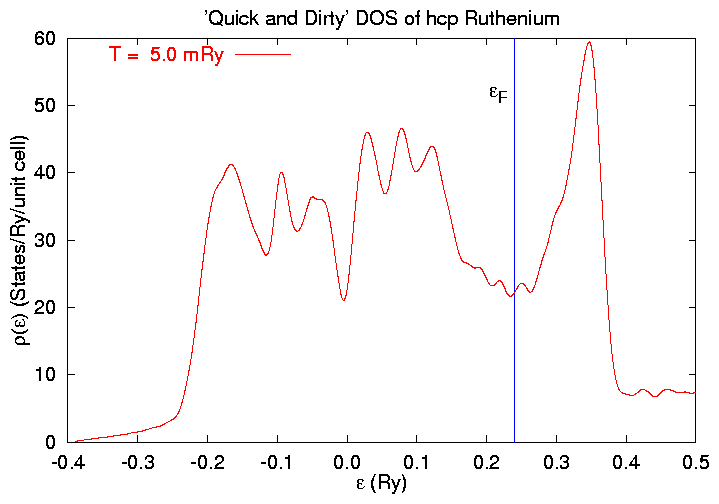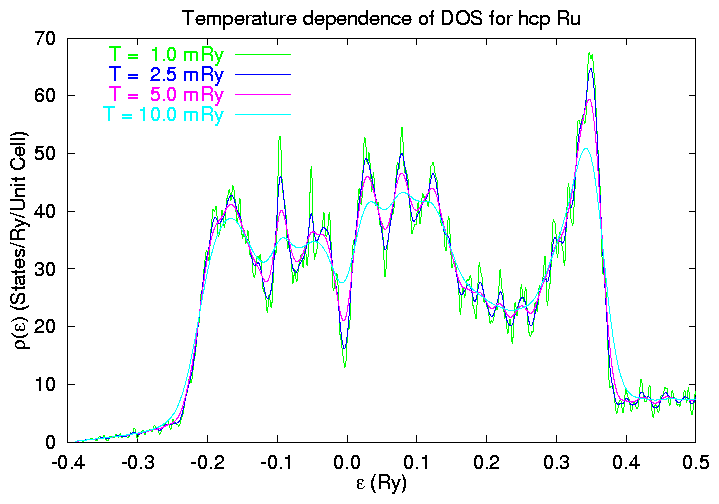
Last Modified 17 December 1999
On the previous page we used static to produce a QLMT file to be used to construct a Density of States for hcp Ruthenium. This page shows how to convert this particular QLMT file into an approximate electronic density of states.
There are accurate ways to construct the DOS, most notably the tetrahedron method, and then there is my way. My way uses the program qdos.f, which produces a ``quick and dirty'' DOS using the implicit formula for the DOS defined by our method of doing eigenvalue-energy sums. A somewhat more detailed explanation of this is contained in the comments within the source code.
Compile qdos.f and place the executable somewhere in your path. Then go to your working directory and run the code.
$ ./qdos 0.005 -0.389 0.500 0.0002 < QLMT > dos_0.0050 |
Let's take a quick look at the output file dos_0.0050. The first few lines look like this:
-.38900 .00067 .10740 1.3784E+01 -.00026
-.38880 .00069 .11017 1.3964E+01 -.00026
-.38860 .00072 .11298 1.4140E+01 -.00027
-.38840 .00074 .11583 1.4309E+01 -.00028
-.38820 .00076 .11871 1.4473E+01 -.00029
-.38800 .00079 .12162 1.4631E+01 -.00030
-.38780 .00081 .12456 1.4783E+01 -.00031
-.38760 .00084 .12753 1.4928E+01 -.00032
-.38740 .00086 .13053 1.5067E+01 -.00033
-.38720 .00089 .13355 1.5199E+01 -.00034
On each line,
.24000 15.99180 22.10841 1.6709E+02 -.01290
.24020 15.99623 22.14216 1.7045E+02 -.01183
.24040 16.00066 22.17657 1.7354E+02 -.01077
.24060 16.00510 22.21156 1.7636E+02 -.00970
experiment 183.661901 .240370332 -.010923624
We can now plot out the DOS for Ruthenium using a gnuplot script:

We can compare this result with the First-principles calculation from NRL's Electronic Structures Database:

Aside from the arbitrary shift in energy, these curves are in
pretty close agreement.
We'll now consider the behavior of the DOS as a function of the
Fermi temperature used in Gillan's method. We can guess that if the
temperature is too small the DOS plot will degenerate into a series
of spikes, and we'll have to have a very fine grid to see them at
all. On the other hand, when the temperature is too large
everything gets smeared out.
The following script calculates the DOS at
every temperature on its command line, assuming the temperatures are
in Rydbergs:
We'll run this for a few representative temperatures:
tscript 0.0010 0.0025 0.0100
and plot them and our original data using this
script:
Our predictions are correct, but over the rather broad range
1 mRy<T<10 mRy this ``Quick and Dirty'' DOS remains
fairly consistent.
Now back to the DOS setup page.
Look at other examples.
Get other parameters from the Tight-binding periodic
table. Return to the static Reference
Manual.
Temperature Dependence of the DOS
#!/bin/sh
for temp
do
./qdos $temp -0.389 0.5001 0.0005 < QLMT > dos_$temp
done
